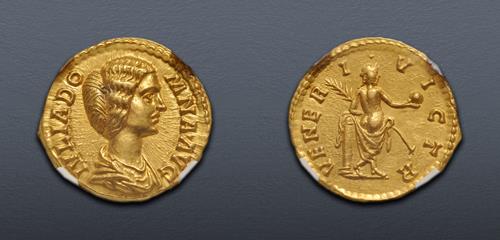|
Julia Domna. Augusta, AD 193-217. AV Aureus (20mm, 7.22 g, 12h). Rome mint. Struck under Septimius Severus, circa AD 193-196. IVLIA • DO MNA • AVG, draped bust right / VENER I • VICTR, Venus Victrix, with drapery falling below hips, standing with back turned, head right, resting left arm on low column, holding apple in extended right hand and in left, palm frond sloped upward to left. RIC IV 536 (Septimius); Calicó 2641; BMCRE 48 (Wars of Succession); Adda 412; Biaggi 1155; Jameson 173; CNG 115, lot 688 (same obv. die); Heritage 3071, lot 34108 (same rev. die). Lustrous. In NGC encapsulation 6155756-001, graded MS, Strike: 5/5, Surface: 4/5.
Ex Burgan (15 January 2021), lot 110.
Julia Domna was of Syrian-Arab ancestry, the daughter of the hereditary high priest of Elagabal at Emesa, a wealthy caravan city in the Syrian desert. Beautiful, cultured, and highly educated, she was made even more of a prize by a horoscope that proclaimed she would marry a king. Septimius Severus probably encountered her family while serving as a general in Syria in the AD 180s. When he learned of the horoscope, the recently widowed Severus, then serving as governor of Gaul in Lugdunum, immediately wrote to Julia’s father and secured her hand in marriage. She gave him two sons, Bassianus (later renamed Antoninus and known to history as Caracalla) in AD 188, and Geta the following year. Upon Severus’ ascension as Roman Emperor in AD 193, Julia was named Augusta and became his closest advisor and confidant. She frequently accompanied Severus and their sons on military campaigns, for which the soldiers granted her the title Mater Castrorum (“mother of the camp”). Her love of art, learning, and philosophy fostered a cultural revival in Rome, with Julia serving as patroness of a diverse salon circle.
Julia Domna’s coinage was more vast and diverse than any previous Roman empress, beginning soon after her acclamation as Augusta in AD 193. One of her first issues was this charming gold aureus type, the obverse of which bears her graceful portrait wearing an early version of her famous wavy, center-parted coiffeur. The reverse depicts her patron deity, Venus Victrix (“Victorious Venus”), a variant of the love goddess that confers victory in battle, and perhaps a subtle allusion to the civil war still underway against Pescennius Niger. The depiction of Venus standing half-draped with her back coyly turned to the viewer recalls issues of Titus and his daughter, Julia Titi, struck 120 years earlier. In this version, Venus holds her traditional apple and a palm branch instead of the helmet and spear seen on the Flavian issues.
The final winners of all CNG Feature Auction 129 lots will be determined during the live online sale that will be held on 13-14 May 2025. This lot is in Session Two, which will begin 13 May at 2 PM ET.
Winning bids are subject to a 22.5% buyer's fee for bids placed on this website and 25% for all others.
We recognize that our users may have various Internet Browsers and Operating Systems. We like our visitors to have the best possible experience when using our bidding platform. However, we do recognize that it is impossible to develop applications that work identically, efficiently and effectively on all web browsers. The CNG bidding platform supports the latest stable major version and stable previous version of Chrome and Firefox.
|
